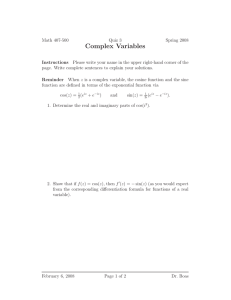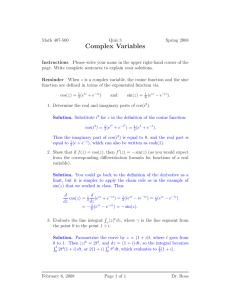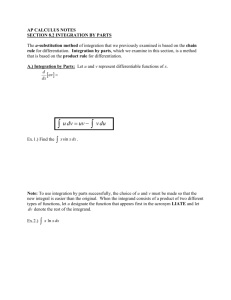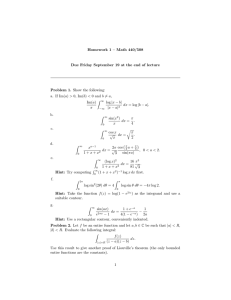Worked Example Contour Integration: Singular Point on the Real Axis
advertisement
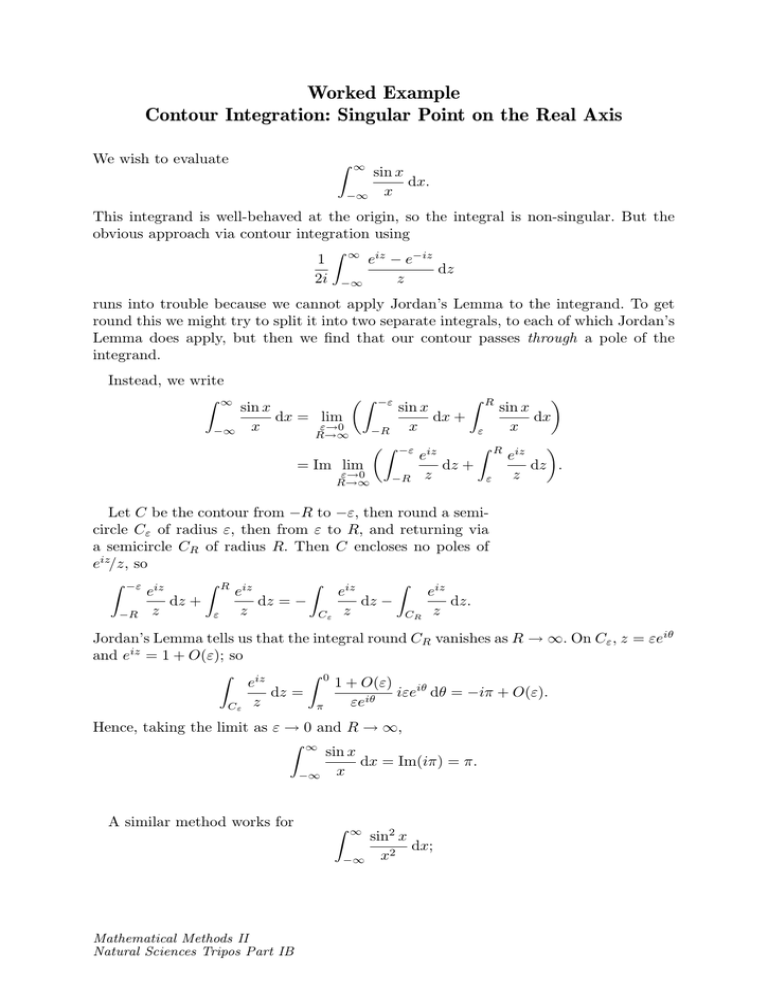
Worked Example Contour Integration: Singular Point on the Real Axis We wish to evaluate Z ∞ sin x dx. x −∞ This integrand is well-behaved at the origin, so the integral is non-singular. But the obvious approach via contour integration using Z 1 ∞ eiz − e−iz dz 2i −∞ z runs into trouble because we cannot apply Jordan’s Lemma to the integrand. To get round this we might try to split it into two separate integrals, to each of which Jordan’s Lemma does apply, but then we find that our contour passes through a pole of the integrand. Instead, we write Z ∞ −∞ sin x dx = lim ε→0 x Z R→∞ −ε −R Z −ε = Im lim ε→0 R→∞ −R R sin x dx x ε Z R iz eiz e dz + dz . z z ε sin x dx + x Z Let C be the contour from −R to −ε, then round a semicircle Cε of radius ε, then from ε to R, and returning via a semicircle CR of radius R. Then C encloses no poles of eiz/z, so Z −ε iz Z R iz Z Z eiz eiz e e dz + dz = − dz − dz. z −R z ε Cε z CR z Jordan’s Lemma tells us that the integral round CR vanishes as R → ∞. On Cε , z = εeiθ and eiz = 1 + O(ε); so Z 0 Z eiz 1 + O(ε) dz = iεeiθ dθ = −iπ + O(ε). iθ z εe Cε π Hence, taking the limit as ε → 0 and R → ∞, Z ∞ sin x dx = Im(iπ) = π. −∞ x A similar method works for Z ∞ −∞ Mathematical Methods II Natural Sciences Tripos Part IB sin2 x dx; x2 write sin2 x = Z ∞ −∞ 1 2 Re(1 − e2ix ), and then Z −ε Z R sin2 x 1 − e2iz 1 − e2iz 1 dx = 2 Re lim dz + dz ε→0 x2 z2 z2 −R ε R→∞ Z Z 1 − e2iz 1 − e2iz 1 = 2 Re lim − dz − dz . ε→0 z2 z2 CR Cε R→∞ The integral round CR can be shown to vanish as R → ∞ by standard techniques (Jordan’s Lemma is not, however, applicable), and the integral round Cε can be evaluated as before (expanding e2iz to slightly higher order in ε than before), giving Z 1 − e2iz dz = −2π + O(ε). z2 Cε Hence Z ∞ −∞ sin2 x dx = π x2 as well! An alternative approach for both examples is to note that, for instance, (sin z)/z has a removable singularity at the origin. Having removed the singularity, we have an analytic integrand, and therefore the original contour along the real axis can be moved to one which does not pass through the origin. It is now possible to write sin z = (eiz −e−iz )/2i, split the integrand in two, and apply Jordan’s Lemma to each part separately. Mathematical Methods II Natural Sciences Tripos Part IB
